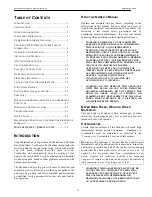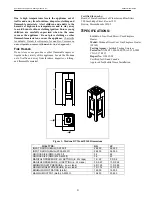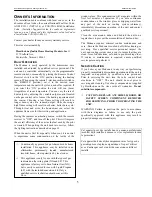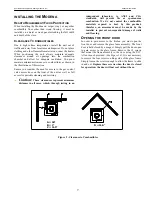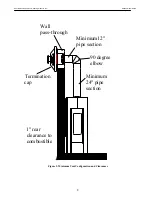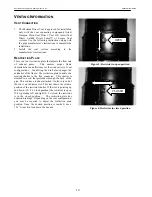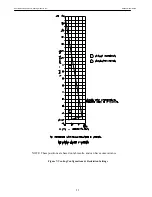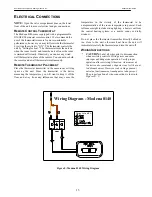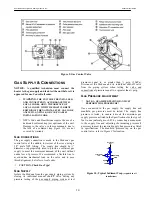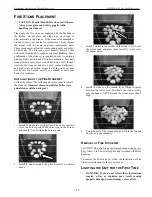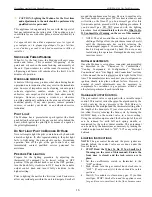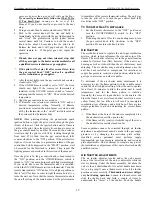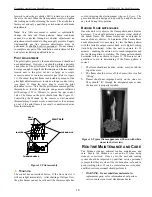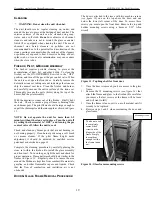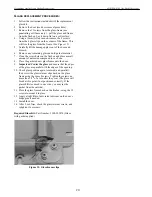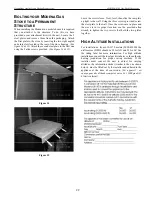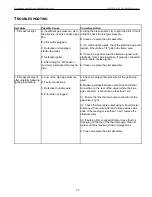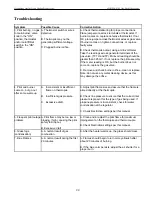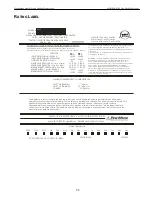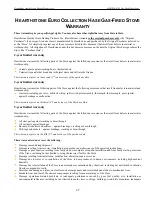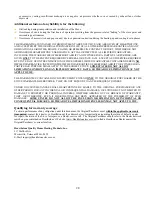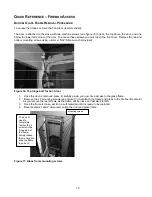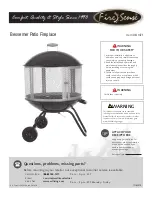
HearthStone Quality Home Heating Products, Inc.
MODENA 8140 Gas-Fired Direct-Vent
17
gases are heavier than air and will settle on the floor.
If you smell gas immediately follow the What To Do
If You Smell Gas! warning on the cover of this
Manual.
If you do not smell gas, proceed to the next
step.
5.
Turn gas control knob counter-clockwise to “PILOT”.
6.
Push in the control knob all the way and hold in.
Immediately light the pilot with the gas lighter (push in
and “click” the piezoelectric spark igniter button
several times until lit). Continue to hold the control
knob in for about 20 seconds after the pilot is lit.
Release the knob and it will pop back out. The pilot
should remain lit. If the pilot goes out, repeat the
operation.
If knob does not pop out when released, stop, shut
off the gas supply to the heater and immediately call
a qualified service technician or gas supplier.
If the pilot will not stay lit after several tries, turn
the gas control knob “OFF” and call a qualified
service technician or gas supplier.
7.
After the pilot lights, turn the gas control knob counter-
clockwise to “ON”.
8.
If the ON/OFF/remote switch is set to “ON”, the stove
should now light. If the remote (or thermostat) is
installed, set the ON/OFF/ remote switch to “remote”
and program the remote to “ON”. Then set the desired
temperature.
9.
Shut the gas control valve access door.
10.
If “Remote” was selected, set remote to “ON” and set
desired temperature setting. Normally, if Remote
position was selected, the main burner is cycled on and
off by the thermostat or the “on/off” switch located on
the bottom of the thermostat body.
NOTE:
When pressing/clicking the piezoelectric spark
ignition button to light the pilot, watch through the glass
(front) of the unit. Click the igniter button until a flame is
visible at the pilot. Once the pilot is lit, continue to press on
the gas control knob for another 20 seconds, then release.
Ascertain that the pilot is still lit by looking through the
front door. If lit, then turn the gas control knob fully
counter-clockwise to the “ON” position. If the pilot fails to
light, or if it went out due to a premature release of the gas
control knob while depressed in the “PILOT” position, wait
60 seconds for the Interlock to release. Then repeat
the
lighting process as described in this section of the manual.
Once the pilot is lit, the gas control knob is been turned to
the “ON” position, and the ON/OFF/Remote switch is
turned to “ON”, the main burner should light immediately.
If you would like to use the thermostat and it is installed,
switch the ON/OFF/Remote switch to thermostat. Turn the
remote transmitter to "ON" and set it to a higher position so
that it "calls" for heat in order to light the main burner (i.e.
turns the unit on). Note that the remote thermostat controls
the on/off cycling of the main burner, but the pilot remains
lit regardless of the remote thermostat setting. The only way
to turn the pilot off is to turn the gas control knob fully
clockwise to the “OFF” position.
T
O
T
URN
O
FF
G
AS
T
O
A
PPLIANCE
1.
Set the Remote thermostat to the “OFF” position or
turn the ON/OFF/REMOTE switch to the “OFF”
position.
2.
If shutting the unit off for the non-heating season, turn
the gas control knob fully clockwise to the “OFF”
position. Do not force the knob to turn.
A
IR
S
HUTTER
The air shutter is used to regulate the air-to-gas combustion
mixture, which in turn influences the size and color of the
flames. The air shutter is factory set in the general location
needed for Natural Gas (NG), however, if the unit is not
burning as well as it should, then the air shutter may need
adjusting. The air shutter may need adjustment once the
unit has been installed to compensate for variations in
supply line pressure, restriction plate position, altitude, fuel
gas type conversions, and other variables.
To determine if the air shutter needs adjustment, it is
necessary to view the flame pattern with the variable output
control knob at its highest setting. Allow the unit to operate
for at least 10 minutes to allow the entire unit to reach
temperature, and for the flame pattern to stabilize.
Generally, the more air (open shutter) in the mixture, the
bluer the flame. Less air (closed shutter) results in a more
yellow flame, but too little air will result in incomplete
combustion, low efficiency and a dirty burn. There are two
simple guidelines to aid in determining the correct flame
pattern:
If the flame at the base of the stones is completely blue,
the air shutter is possibly open too far;
If the flame is dirty (sooty) or licks the top of the stove,
the air shutter is possibly closed too far.
Some conditions cannot be corrected through air shutter
adjustment; an adjustment must be made to the gas supply
pressure or by changing the restriction plate setting.
Qualified service personnel must perform supply
line/manifold gas line pressure adjustments and restrictor
plate adjustments. Do not attempt to complete any part of
the installation or adjustment of this unit unless technically
qualified to do so.
A
IR
S
HUTTER
A
DJUSTMENTS
The air shutter adjuster, located under the valve access
door, at the lower front of the unit, is adjustable while the
stove is burning. Under the burner assembly, but above the
valve is the air shutter handle. It is a steel handle bent down
for you to grasp. It uses a thumb screw to lock the shutter
position once set correctly.
This handle and screw will get
very hot during operation
. Loosen the thumb screw and
slide the shutter back and forth a couple of times to
understand the “throw” of the shutter. Push the handle

